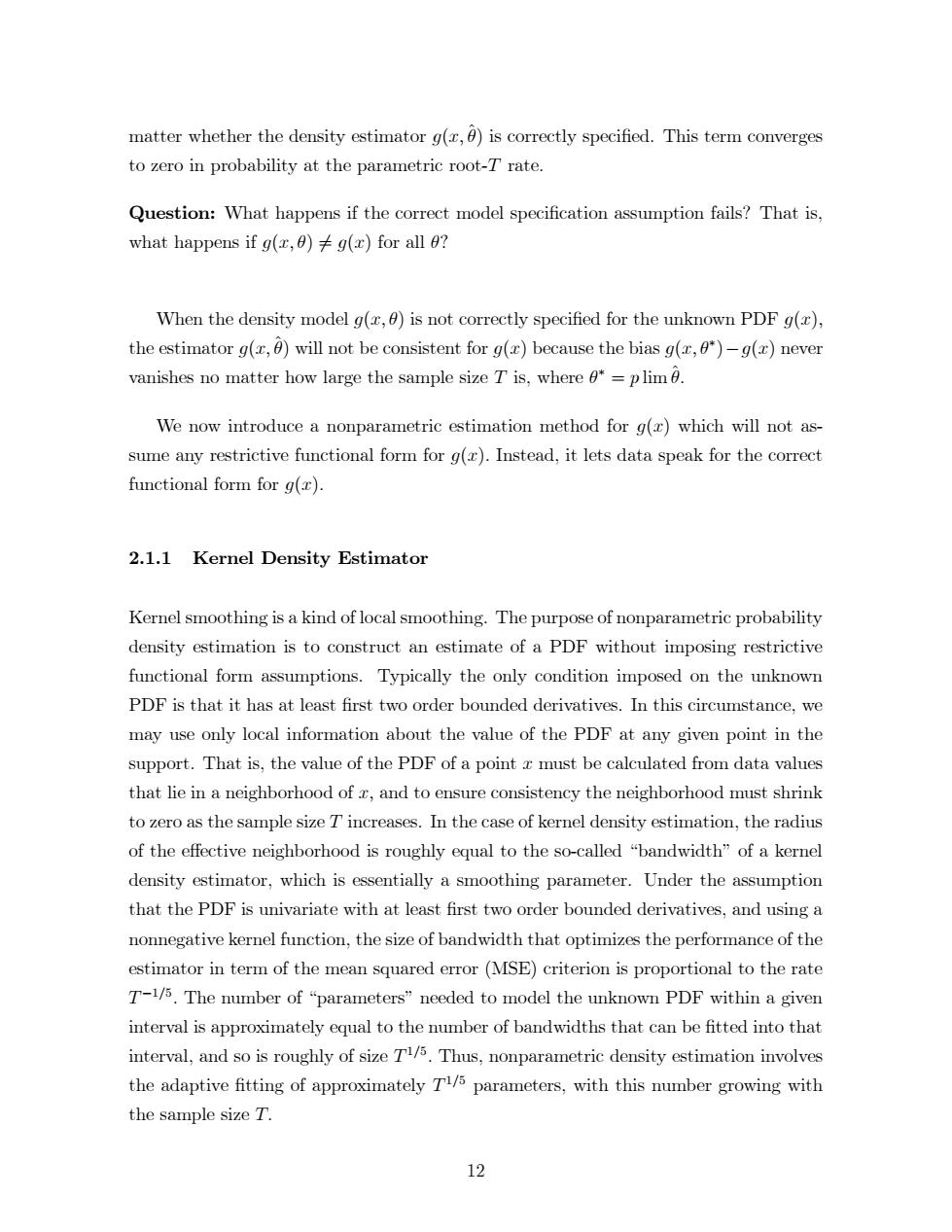正在加载图片...

matter whether the density estimator g(r,0)is correctly specified.This term converges to zero in probability at the parametric root-T rate. Question:What happens if the correct model specification assumption fails?That is, what happens if g(,0)g(x)for all 0? When the density model g(r,0)is not correctly specified for the unknown PDF g(r), the estimator g(,0)will not be consistent for g()because the bias g(,)-g(z)never vanishes no matter how large the sample size T is,where *=plim. We now introduce a nonparametric estimation method for g(x)which will not as- sume any restrictive functional form for g(x).Instead,it lets data speak for the correct functional form for g(r). 2.1.1 Kernel Density Estimator Kernel smoothing is a kind of local smoothing.The purpose of nonparametric probability density estimation is to construct an estimate of a PDF without imposing restrictive functional form assumptions.Typically the only condition imposed on the unknown PDF is that it has at least first two order bounded derivatives.In this circumstance,we may use only local information about the value of the PDF at any given point in the support.That is,the value of the PDF of a point x must be calculated from data values that lie in a neighborhood of z,and to ensure consistency the neighborhood must shrink to zero as the sample size T increases.In the case of kernel density estimation,the radius of the effective neighborhood is roughly equal to the so-called "bandwidth"of a kernel density estimator,which is essentially a smoothing parameter.Under the assumption that the PDF is univariate with at least first two order bounded derivatives,and using a nonnegative kernel function,the size of bandwidth that optimizes the performance of the estimator in term of the mean squared error(MSE)criterion is proportional to the rate T-1/5.The number of"parameters"needed to model the unknown PDF within a given interval is approximately equal to the number of bandwidths that can be fitted into that interval,and so is roughly of size T/5.Thus,nonparametric density estimation involves the adaptive fitting of approximately T/5 parameters,with this number growing with the sample size T. 12matter whether the density estimator g(x; ^) is correctly speciÖed. This term converges to zero in probability at the parametric root-T rate. Question: What happens if the correct model speciÖcation assumption fails? That is, what happens if g(x; ) 6= g(x) for all ? When the density model g(x; ) is not correctly speciÖed for the unknown PDF g(x); the estimator g(x; ^) will not be consistent for g(x) because the bias g(x; )g(x) never vanishes no matter how large the sample size T is, where = p lim ^: We now introduce a nonparametric estimation method for g(x) which will not assume any restrictive functional form for g(x): Instead, it lets data speak for the correct functional form for g(x): 2.1.1 Kernel Density Estimator Kernel smoothing is a kind of local smoothing. The purpose of nonparametric probability density estimation is to construct an estimate of a PDF without imposing restrictive functional form assumptions. Typically the only condition imposed on the unknown PDF is that it has at least Örst two order bounded derivatives. In this circumstance, we may use only local information about the value of the PDF at any given point in the support. That is, the value of the PDF of a point x must be calculated from data values that lie in a neighborhood of x; and to ensure consistency the neighborhood must shrink to zero as the sample size T increases. In the case of kernel density estimation, the radius of the e§ective neighborhood is roughly equal to the so-called ìbandwidthîof a kernel density estimator, which is essentially a smoothing parameter. Under the assumption that the PDF is univariate with at least Örst two order bounded derivatives, and using a nonnegative kernel function, the size of bandwidth that optimizes the performance of the estimator in term of the mean squared error (MSE) criterion is proportional to the rate T 1=5 : The number of ìparametersîneeded to model the unknown PDF within a given interval is approximately equal to the number of bandwidths that can be Ötted into that interval, and so is roughly of size T 1=5 : Thus, nonparametric density estimation involves the adaptive Ötting of approximately T 1=5 parameters, with this number growing with the sample size T: 12��